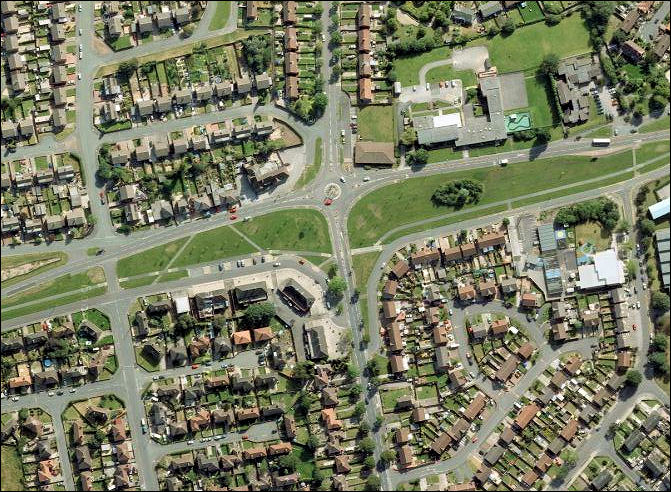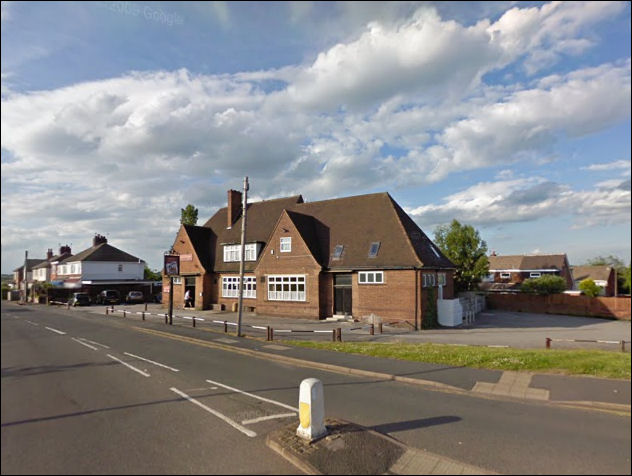|
Chell Heath - that the frontier spirit lives on
Defenders of the reputation of Chell Heath still wave aside all attempts at redemption and reconciliation for its lurid past. Its very name catches the breast in shock and awe on the old terraces of Boothen and Bycars, and even now, so I’ve heard, there are still inhabitants who bask in the shadow of the High Plains Drifter, the Man With no Name – the legendary Chell Heathen as he rides into the sunset of the bad lands. Like Tombstone Arizona, Chell Heath Stoke is a ‘Town too Tough to Die.’
The wide crossroads of Sprink Bank Road and Chell Heath Road still evoke the atmosphere of the Wild West in an illusion of a prospecting shantytown. Perhaps film director John Sturges had this location in mind when he made Gunfight at the OK Corral for the showdown between the Earp’s and the Clanton’s at 12 o’clock high on a summer’s day under a hot barren sky as God-fearing folk quaked behind twitching curtains.
A lone cloud passes over Boot Hill; a bunch of tumbleweed blows through the gullies, a slow ticking clock above the bar in the Knave of Clubs counts the seconds to… hang on – where! The Knave of Clubs!
It’s easy to get carried away in Chell Heath; it’s that reputation thing I guess. Nevertheless it is a status that has roots set in truth. Down the ages both Chell Heath’s lawmen and outlaws carry the same resonance as the Earp’s and the Clanton’s. But, let’s be honest about it, without Burt Lancaster and Kirk Douglas, Tombstone would have been about as celebrated as – well, Chell Heath.
And so I tether my mule and make my way across the corral, my spurs jangling in the hard dusting to arrive the Longbranch Saloon where I find the bartender handing out slugs of rye to his dead-end amigos. Sorry, I’ll start that again. I parked my car on the Knave of Club’s car park and call in to see the licensee, Roy Spilsbury, who was sipping tea while taking a break from a bit of DIY and having a chat with his customers, octogenarian Bill Cooke and his mates, pensioners Roy Farr and Walter Brindley.
These early prospectors – I mean former miners – came to Chell Heath when their homes in Burslem and Tunstall were declared unfit for habitation. These are Chell Heath’s original settlers – the frontiersmen.
“I worked in Sneyd and Wolstanton collieries all my life. I Came to Chell Heath just after it started and it’s become my real home,” says Bill. “People say Chell Heath is rough,” interjects Walter, “but I tell you life for people who came here was already rough and couldn’t be rougher; they were factory workers and miners who were used to hard work and a hard way of life. I arrived in 1951, same time as Billy and Roy. It was tough going to start all over again. Then, I lived in Recorder Grove. Some called it Peyton Place, but I won’t say why,” he smiles seductively, but I could tell he was referring to adulterous naighbours.
Call me unconventional but street naming has always held a fascination for me. In Chell Heath most are straightforward: Dog Croft, Corn Hill, Barn Croft, bucolic names that hint of medieval parishes. Then there are some names that are representative of civic do-gooders and estates constructors – Ward, Whitehead and Sutton. Some though are aptly commemorative like Baskeyfield Place after the Victoria Cross soldier and Monks-Neil Park notable for the councillor in charge of Stoke on Trent’s policy of industrial land reclamation. But which Stoke on Trent estate planner holidayed in the Cumbria village of Salkeld I wonder – he must have loved it to name Salkeld Place after it!
Before 1951 Chell Heath was a pastoral stretch of land descending from the township of Chell which, in 1841, covered an area of 740 acres including its extensive and rather beautiful heath land. After the boundary changes in 1910 the district was divided in two – Great Chell and Little Chell, although there are no records to say why. The Parish of St Michael was created in 1925 and it included the two Chells as well as Pittshill, Turnhurst and Fegg Hayes – tranquil colliery villages. All this changed in 1951 when the miners’ houses and the new council estate opened across the lower part of the heath.

Cornhill Road is the widest little street in the whole of North Staffordshire

Chell Heath estate was validated with advanced designs that were years ahead in planning and layout. Cornhill Road is the widest little street in the whole of North Staffordshire with spacious pavements and grass verges; houses with fenced-in front gardens constructed for total independent living.
Indeed it’s more like a square than a street because of its expansive dimensions. Integral features were given over to the joy of space, a space that had never before appeared in the lives of the new residents who had come from cobbled-lane back-to-back terraces that shared shadowy corners with potbanks.
Into this ample haven the slum-dwellers of Burslem and Tunstall were decanted; folk who had never smelled the country let alone lived in it. For them there was almost nothing quite as lovely as a meadow full of wildflowers and grasses swaying in the summer breeze, butterflies flitting around, bees buzzing, birds singing, the sun shining. This was the Paradise that the labouring communities with dust-lined lungs and twisted joints came to experience as their new home. It was the great escape; so what went wrong, what happened to that virgin joyous pride?
Former key member of Chell Heath
neighbourhood, Harold Harper, holds to a provocative view over what went wrong.
“Prior to slum clearances, living in claustrophobic units under the same fateful circumstances as your neighbour settled your values and outlook,” says Harold. “In slums you had a pool of the same amenities which were totally out of your independent control. Alleys at the rear of properties were shared; chimney stacks, roofing space – even lavatories and communal drinking water stands were in common ownership. So you looked to your neighbours for help and in return you looked after them. As a consequence there was little criminal activity among communities; it was like a cloistered brotherhood that looked to itself.
Now, imagine all these close-knit families being landed with strangers in communities on a wide open estate where each pair of houses was separated by open plan gardens, open backs and airy and uncluttered streets. People who’d lived in terraced warrens suddenly having miles of space to their own diversions. They soon found that they no longer needed neighbourly support or even neighbourly contact. They became detached; overnight friends became adversaries.”
Harold and others realised this trend early on and campaigned to build Chell Heath’s only community centre – the British Legion Club. But the club, hugely successful at first under Harold’s chairmanship, was ill-fated and struggled under anti-social behaviour of a minority that became a majority, and eventually closed but for administration irregularities.

In the new Chell Heath the common landlord was the corporation. Tenant rights were supported by the Welfare State and the payments of rent were insured by welfare benefits. Nationalisation of public services sheltered the tenant from landlord intimidation, and social legislation guaranteed protection for the homeless and the workless and their ability to pay rent. Way back housing and health was the principal role of the local council as slums were cleared and replaced with a healthy environment. But the success of this unique policy failed to take into account the unexpected sociological changes that came with the hasty fragmentation and wholesale transferral of common working class communities to the outreached and disconnected estates. Subsidised mass house-building soon found its Achilles heel crippled by ASBO-trends for which a permanent remedy has yet to be found.

Knave of Clubs,
Chell Heath Road
Google Street View
Nowadays Chell Heath Tuesday Club meets in a back room of the Knave of Clubs because after all these years Chell Heath still has no purpose-built community centre. This fifty-strong group of frontierswomen have been meeting here for five years. They used to meet at the Methodist Church hall but they had to leave when it was discovered that the ministry didn’t allow gambling and, naturally, the ladies love a game of bingo.
Resident Lorna Riley says, “For years the council has been promising us a community centre. We used to have the British Legion but that was demolished and replaced by a housing office.”
Hilda Bossons came to Chell Heath in 1953. She also remembers the promises. “It was Joan Phillips who got our club going. In those times we met in the school.”
Joan Phillips MBE was the chair of Chell Heath Priority Estates Programme in 1990 and her council-supported committee, including this author as a council elected representative, secured government money for the restructuring of trouble spots, the provision of new amenities, the modernisation and the bringing of the houses up to modern standards. Giant steps forward were made but the sought after community hall failed to materialise. As one Tuesday Club member puts it, “Chell Heath is still as bad with vandalism and neglect – better, yes, but it could be much better still.”
Some people must like Chell Heath and drawn to it. Additional private housing has been a major feature in stabilising the enlarged community, and since 1981, 643 tenants have exercised their right to buy their rented homes. In the next twelve months (written in 2004) the council will unveil a ten year plan under the Housing Market Renewal Pathfinder programme, and who knows the Chell Heath Tuesday Club and Bingo aficionados may yet find a permanent home.
Meanwhile Roy Spilsbury ploughs onward with his backroom extension. “The police closed the Knave down on New Years Eve in 1996,” Roy remembers. “Shotgun Alley as it was known then. Two years later I bought the freehold. I cleared out all the bad elements and I reckon it now looking good.”
I still get the feeling that the frontier spirit lives on in Chell Heath. And when the going gets tough I can imagine Roy taking his silver star out of the drawer in the sheriff’s office as the Clanton boy race for cover.
Fred Hughes

|
![]()
![]()
![]()